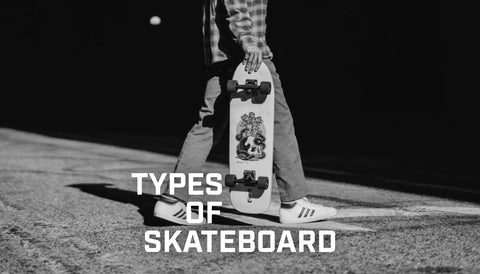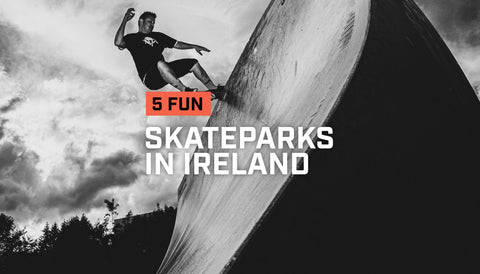An overview
If you’re brand new to skateboarding (and we’ll assume so if you’ve found this guide), the first thing you’re gonna want to know is the differences between the many types of boards out there!
Unlike other, overly complex and overwhelming, guides we came across, we wanted to make this as simple as possible for you to encourage your skateboarding journey and help you to make your first skateboard purchase.
Simplicity is the key, BUT if you’re still confused after reading the guide, hit us up on email with any questions.
Different types of skateboards:
Although there are many different types of skateboard it pretty much comes down to two (well, 3) categories. These categories will help you decide on riding style before getting into the nitty gritty of the sub-categories and specialist boards. It ultimately comes down to: Longboards, Shortboards and Electric Skateboards. Read on to find the best skateboard for you.

1. Types of Longboard
If you are looking to cruise, carve or bomb big hills, you’ll want a longboard of some sort. Longboards can be broken down into the following categories:
Cruiser Boards
Cruiser boards are what comes to mind when you say ’longboard’. They are designed to get you from point A to point B, while offering a flow-y, carve-y ride that more mimics riding a snowboard. Beginners would want to start here to get the feel of riding a longboard.
These can come either ‘Top Mounted’ or ‘Drop Through’, referring to the way the trucks are mounted to the deck.
Cruiser longboards can come in many shapes. Most popular are Pintails like the Sector 9 Shoreline Ledger, Twin Tips and Double Drops.
If a cruiser longboard sounds like what you’re after, explore all the different shapes and things to consider in the ultimate longboard deck guide.
Freestyle / Dancers
These are for those who want to do flip tricks and/or dance on their longboard. These are double kick skateboards that are a little smaller, lighter and sit lower to the ground than the cruiser longboards mentioned above to allow for improved maneuverability.
Freeride / Downhill Longboard
These boards are designed for high speeds and are usually heavier and stiffer to avoid speed wobbles. We would not recommend beginners try freeride or downhill longboarding to begin and therefore won’t get into further details of shapes etc.
If you do want to know more, check out the ultimate longboard deck guide.
LDP (Long Distance Pumping)
Boards built specifically for long distance pumping and slalom. Similarly to Surf Skates (below) the aim of the game with these is to pump, not push.
There are also some long distance push skateboards. These are typically drop through and dropped deck to allow for the easiest push, minimizing effort per push. They are also frequently made from exotic materials, like carbon fiber / fiberglass.

2. Types of Shortboard
If you’re looking to hit the skatepark, vert ramp, street skate or want something to stash in your locker at school, you’ll want a shortboard! Shortboards are made up of the following sub-categories:
Street Skateboards (Aka Double Kick or Popsicle)
These are what you may refer to as a traditional skateboard, standard skateboard or popsicle skateboard. Whatever you wish to call it, the boards feature an angled kicktail on one end, and angled nose on the other, for popping up curbs & flip tricks. Typically, they run around 32” in length and come in different sizes of widths so you can choose your preference based on your skateboarding style:
Wider boards (8.75” - 9.5”) are typically used for ramps and pool skating as it gives greater stability.
Narrower boards (7.75” - 8.5”) are typically used for performing tricks. Of course, these are not hard and fast rules and you’d want to try a few sizes at your local shop before picking up your first one.
If you are starting from scratch, you will want a fully built out complete skateboard (vs choosing your skateboard deck and components). This would usually come with smaller hard wheels and traditional kingpin (TKP) trucks.
These boards usually will come in hard smaller wheel sizes, ranging from 50mm to 60mm.
Mini Cruiser Skateboards
These are usually around 28 - 32” in length and are designed for getting from point A to B, while still offering some ability to perform tricks. They typically have soft wheels to allow you to cruise over small rocks and debris and sit a little higher off the ground than your standard skateboard to allow for better maneuverability.
In terms of widths popular mini cruisers run 8.5” to 9”, giving you a little more width and therefore stability when cruising. Mini cruisers are great for commuting due to their size and portability Unlike regular size cruisers, you can throw it in your trunk or stash in your college locker with ease.
Most Mini Cruisers also come with a directional kicktail (but no nose) to allow you to ollie and perform a lot of the tricks you’d be able to on a regular skateboard while cruising around town.
There are also even smaller boards like Penny Boards which are sometimes classified as ‘micro cruisers’. Personally we would advise you steer clear of these as they are too small to really skate for more than 5 minutes and offer far less in terms of diversity than most regular mini cruisers. They are also mostly plastic, which does not ride as well or tend to last as long as maple.
Old School Skateboards
Old school boards are becoming more and more popular, with a lot of this credit going to the Powell-Peralta Re-Issue series featuring replica decks that the likes of Tony Hawk, Rodney Mullen and the whole Bones Brigade team rode back in the 80s.
The boards are wider (9 - 10”) and mostly flatter than their modern counterparts, often just having a single kicktail and no angled nose. That said, you can still perform many freestyle tricks.
Surf Skates
Smaller boards that have specialized truck systems to allow you to carve much tighter than you’d otherwise be able to, replicating that shortboard surfing feeling on land. The decks are wider than usual to provide more stability and seem to be shaped more like a surfboard, although realistically this does not provide any benefit to the rider. You can actually convert any skateboard into a surfskate with the Waterborne Surf Adapter.
There aren’t really too many different styles available when it comes to surfskates. Unlike Surfboards which come in a bunch of shapes, skateboard surfskates are all around the size of a popsicle deck at around 31/32inch in length. Longboard surfers would probably want to stick to a larger longboard skateboard.
Surf Skaters will want a sharp lipped, softer wheel to provide maximum grip when carving.
3. Electric Skateboards
If you’re looking to go 30MPH while exerting as little effort as possible, an E-skateboard is for you.
Electric skateboards can come in both longboard and shortboard styles and are mostly controlled by a handheld remote control that allows you to speed up and slow down. If you are looking for a e-skateboard we would most definitely recommend getting used to it in a secure area (such as an empty parking lot) as we find the controls take some getting used to. Expect a few close calls while getting the hang of it.
Functionally, electric skateboards work in the exact same way as regular longboard skateboards but the back truck features a belt drive that propels the board forward and backwards. Carving and cruising are still very much possible, but you’ll struggle to perform any real tricks on these boards.
Aside from the electric motor, the other main thing you’d notice with an e-board is larger wheels, usually running from 80 - 100mm. Obviously (with all else equal) the larger the wheel the faster you’ll go but the slower you’ll accelerate. This gives you somewhat of an option to choose a faster acceleration or faster top speed, in a similar way to, say, switching out the sprocket on your bicycle or motorcycle.
Skateboard Anatomy & Components
Now that you’ve got an overview of the main skateboard types, we will touch upon the anatomy and components that ALL types of skateboard will consist of.

Skateboard Deck
The deck is 1 of 5 main components that differentiates between the type of board. A skateboard deck is the wooden part of the board that you stand on and comes in a variety of shapes as you will have learned above. If you are unsure as to what size your would need, we recommend hitting up your local skate shop to physically stand on the boards and get some in-person advice.
The other thing that we didn’t mention above is the wheelbase. Skaters usually measure the wheelbase of the deck from the lower inner bolt hole to the upper inner bolt hole, thus dictating how far apart the trucks sit.
Why is this important? It allows you to know how sharp you’ll be able to turn - the smaller the wheelbase, the sharper the turn, and vice versa.
NOW. This is only a base idea as different trucks put the wheels in different positions. Learn more about this by checking out ShredShack’s guide to wheelbase.
Skateboard Trucks
The goal of the trucks is to attach the deck to the wheels.
Skateboard trucks come in two types: Reverse Kingpin (RKP) or Traditional Kingpin (TKP).
Reverse kingpin trucks work in... you guessed it.. reverse to standard TKP trucks to allow for tighter turning. They are usually found on longboard set up for cruising and carving. Traditional kingpin trucks are what you would find on any regular skateboard setup and are best for grinding.
Each skateboard truck features a set of urethane bushings that dictate the amount of turn / lean that you can achieve. If you find your board does not turn enough after loosening your trucks at the ‘axle nut’, we would recommend upgrading your bushings.

Skateboard Wheels
The last components of differentiation between shortboards and longboards is the wheels. Wheels are made from polyurethane and come in a variety of sizes and durometer (hardness).
Harder, small wheels are more aimed at street or standard skateboarding. They range from 50mm to 60mm in diameter and from 90a to 100a on the A Scale of Durometer.
Softer larger wheels are pretty much better for everything else. They range from 60mm on the low end, to 80mm+ on the high end for some longboards. Durometer-wise they range from around 75a to 90a.
Skateboard Bearings
These are fitted inside the wheel and allow the wheel to smoothly rotate on the axle of the truck.
Bearings work universally for both longboards and skateboards. Head over to our skateboard bearings page to learn more about bearings. If you don’t want to do that, here are a few tips to get you started:
- The ABEC system is not related to skateboarding. Don’t be fooled by marketing tactics of, honestly, way too many bearing brands! ABEC 3/5/7/9 are no-go’s.
- The bearings are probably going to make the biggest difference to your board (along with wheels). If you’re buying a cheaper board to see if you like skateboarding, this would be the first thing we’d switch out.

Skateboard Hardware
Skateboard hardware holds the deck to the trucks. They consist of 8 bolts and 8 nuts, and come in 3 main head types: Flat Allen, Flat Phillips and Button Allen.
- FLAT PHILLIPS - The classic skateboard hardware head. Sinks into the board to provide maximum fastening strength on top mounted boards. Requires a Phillips Head bit or driver. These cannot be felt under feet.
- BUTTON ALLEN - Sits atop the deck or trucks, rather than countersunk like the Flat Allen and Flat Phillips. Requires a 1/8” Allen bit or driver. Comes with stainless steel washers to prevent damage to deck or trucks. Works best on drop-thru decks, but still works on top mounted decks. The bolt head can be felt under feet, allowing riders to correct foot placement.
- FLAT ALLEN - Uses the same head shape as the Flat Phillips, except requires a 1/8” allen bit or driver, for reduced risk of stripping. These cannot be felt under feet.
Griptape
The sandpaper-like sheet that is stuck to the top of the deck. It helps you to stay on the board whilst moving. Learn more about Skateboard Grip Tape.
There are different grit sizes available, but pretty much if you are buying new grip for any board other than a freeride downhill deck, pick up Jessup or MOB. These have been around years and are tried and tested formulas that work.
Closing
That about wraps it up for our simple guide to the types of skateboards out there in the world. We hope this has provided the insight that other guides didn’t, and helps in your search for your first skateboard! We tried to keep it simple as we know it can quickly become overwhelming when starting out with a new hobby. Hopefully you haven’t, but if you did find ANY of this confusing, don’t hesitate to email us help@fireballsupply.co and we will answer any questions you have.




